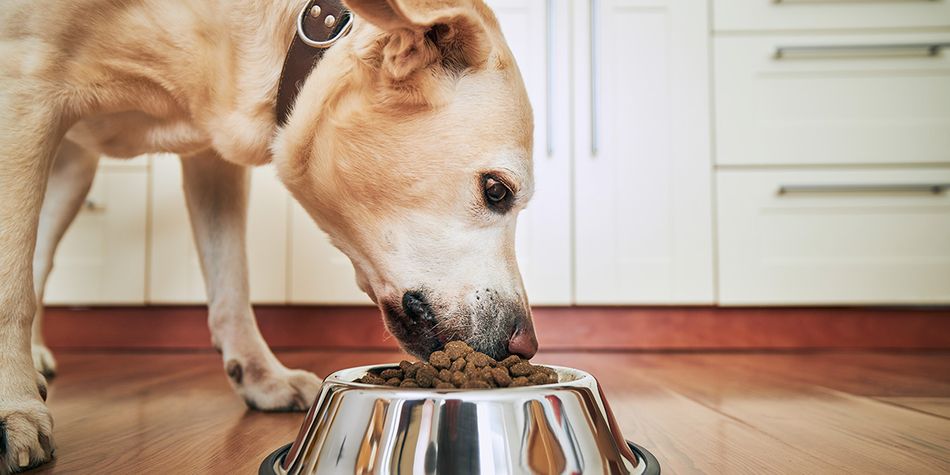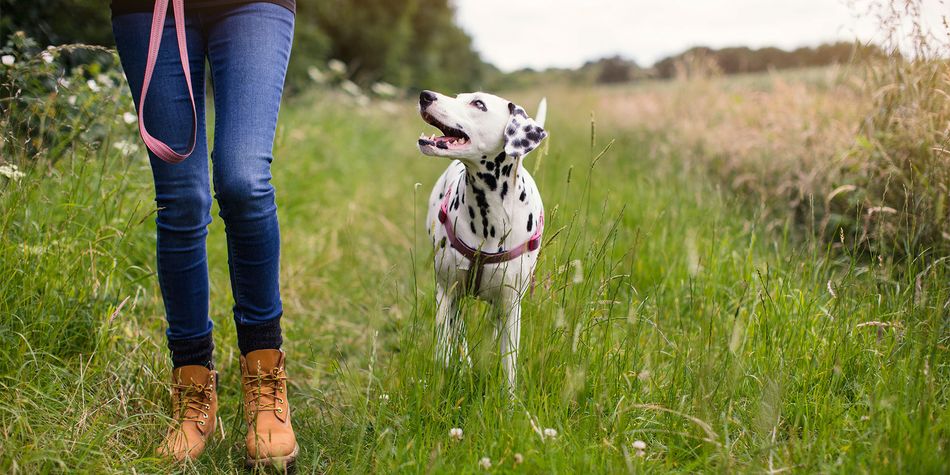By clicking a retailer link you consent to third-party cookies that track your onward journey. This enables W? to receive an affiliate commission if you make a purchase, which supports our mission to be the UK's consumer champion.
How to stop your dog from overheating in the hot weather, according to an expert

When temperatures rise, it’s essential to protect your dog from overheating – especially if they’re older or have a thick coat – whether you're out walking or relaxing at home.
To help pet owners navigate hot spells, we spoke to Anna Ewers Clark, veterinary standards lead at the animal welfare charity Blue Cross.
She gave us some practical tips on spotting the early signs of heatstroke and explained why products like cooling coats aren’t always as helpful as they seem, often warming up quickly and trapping heat.
Keep scrolling for everything you need to know to keep your pet comfortable. You’ll also find advice on homemade frozen treats that are simple to make and safe for dogs.
Be inspired to make home improvements. Sign up for our free monthly Home newsletter
- Don't take your dog out if it's too hot Most dogs are comfortable in temperatures up to 20°C. If it’s any hotter, the risk of heatstroke increases, especially for overweight dogs, very young or elderly pets, and breeds with thick coats or flat faces.
- Learn how to identify heatstroke Watch for signs of overheating, such as panting (especially if the tongue is curled) or heavy breathing. Serious symptoms can include vomiting, collapse or seizures.
- Prepare snacks and treats Make sure your dog has access to clean, fresh water at all times. You can make peanut butter bites with just three ingredients (see below). Dog
ice creams from stores should be given in moderation as they can be calorific. - Consider cooling products We look at the pros and cons of popular cooling products, including mats, coats and paddling pools, to help you decide what’s worth trying and what might not be as effective as it seems. A Which? Best Buy fan could also help.
- Tackle excess fur Brush your pet regularly, as it prevents heat from being trapped in their coat.
- Never leave your dog alone in the car Even
in the shade, it only takes a few minutes for a car to become dangerously hot.
Walking dogs in hot weather
You might think treating your dog to a walk in the summer sun is a nice idea. However, depending on the temperature, it could do more harm than good, and some breeds are more vulnerable to heat than others.
Anna told us: 'Flat-faced dog breeds, such as French bulldogs and pugs, can struggle in hot temperatures, along with overweight pets, very young or elderly animals, and those with thick coats.'
Blue Cross told us that although darker colours tend to absorb more heat, there’s no evidence to suggest that black dogs are more prone to heatstroke than dogs with other coat colours. Breed, age and body condition score have a much greater impact.
Temperatures up to 20°C are suitable for most dogs, so bear that in mind before you step out of the house. Hotter weather can put dogs at higher risk of heatstroke.
Anna adds: 'If you’re not sure whether the pavement is too hot, place your hand on the surface for five seconds. If it’s too hot for your hand, it’s too hot for your pet.
'For times when you can’t avoid going out on pavements (for example, if your pet needs a toilet break), try to avoid periods when the entrance or exit is in direct sunlight. You can also bring a towel to place over the pavement to help your pet reach the grass safely.'
You can get protective boots to help dogs in the heat, although Anna doesn’t recommend them. She says: 'Protective

Attaching a lead to a dog harness gives you more control over your pet than a traditional collar. See our guide to the best dog harnesses
How to identify heatstroke in dogs
It's important to familiarise yourself with the signs of heatstroke to spot them early and act quickly.
Early signs that your dog might be struggling with the heat include:
- Panting (especially if their tongue is curled)
- Slowing down or stopping on walks
- Fast or heavy breathing.
After this, you might see them drooling or lying down, followed by more serious symptoms such as vomiting, collapse or seizures.
If you think your dog has heatstroke, get them to a vet as quickly as possible.
It’s true that wetting the stomach and other thin-furred areas can help cool a pet more quickly, but if they have heatstroke, continuously pouring cold water over their entire body will be more effective than targeting specific areas. For pets with thick or waterproof coats, it’s important to ensure the water reaches the skin. You can check this by looking to see if the fur appears fully saturated and wet all the way down to the skin, which will help cool them more efficiently.
You can use wet towels to cool pets down, but after a couple of minutes, they can start to act as extra insulation. Remember to remove or re-wet the towel regularly to keep it cool.
Best pet insurance providers 2025: we surveyed 1,300 pet owners in the UK and analysed more than 300 policies to reveal which company excels
Food and drink for hot weather
While fresh, clean water is essential during warmer weather (and adding ice cubes can help keep it cool), there are plenty of fun ways to treat your pet to something refreshing.
The Blue Cross website recommends homemade peanut butter bites, which you can make by mixing yoghurt and peanut butter together in a bowl. Then cut an apple into small chunks, making sure to remove the core, pips and stalk.
When it comes to dog-friendly ice creams you might spot at kiosks, coffee shops or supermarkets, Anna told us: 'These are safe, but should be given, like any treat, in moderation as they are quite calorific.
'Owners should avoid feeding their pets human ice cream, as this can contain harmful ingredients for dogs.
'This includes lactose, the sugar found in dairy milk, which dogs can’t digest and may cause stomach upsets. Flavours and additives can also be dangerous. For example, chocolate is toxic to dogs.'
Tips from our team:

'In hot weather, I freeze bone broth into ice cubes and give them to my dog, Peggy.
'These mini snacks are a simple, mess-free treat that helps keep her cool and hydrated. She really loves the taste, plus I like knowing they’re nutritious for her.'
Which? home editor Jade Harding (owner of Peggy the whippet)

We surveyed more than 2,000 dog owners to uncover the food that customers (and their pets) love. Explore our guide to the best dog food brands
Keeping your home cool
During particularly high temperatures, Anna says leaving pets inside is always the safest option. But even so,
'We recommend leaving your pet in a shaded room, such as one with the curtains closed, and opening windows if it's safe to do so, especially when the air outside is cooler or there's a breeze.'
Try placing a fan a short distance from your dog’s usual nap spot. Make sure they have space to move away from the breeze if they want to.

See our expert guide to the best fans for cooling for a pleasant, quiet breeze, or discover the best portable air conditioners
Cooling mats and coats
From cooling mats and coats to paddling pools, there are plenty of summer accessories that can help keep your pet comfortable. But do they all work?
Cooling mats are usually safe for dogs to use, as many contain non-toxic gel. But Anna advises checking the packaging carefully before use, especially if your dog is prone to chewing toys or bedding.
She says: '
The same applies to cooling coats, as she warns:
Tips from our team:

'We bought cooling mats for our two Boston Terriers as we thought they would help to keep them chilled on our car journeys across Europe.
'We thought we'd get them acclimatised to the mats before we headed off on our travels to ensure they felt comfortable lying and sleeping on them. However, they like to scratch to make their bed before they settle down for sleep. The cooling mats weren't spared this.
'This meant they had sprung leaks in a few places before we'd even taken them anywhere. My husband tried to rescue the mats with a puncture repair kit, but it was just a short stay of execution for them, and they were soon weeping again – and then quickly into the bin. Not something we'll be shelling out for again.
'We did find another way to keep our dogs cool on longer journeys, though. They love cheese more than anything, so I always travel with a few mini Babybels.* I crush half of one into a few chunks and drop them into their water bowl during our stops. They go Babybel bobbing while keeping themselves hydrated at the same time.'
Which? senior editor Daniella Delaney Mendes (owner of Mr Darcy and Lizzy the Boston terriers)
*Blue Cross says dogs can eat cheese (except for blue cheese), but like all treats, it must be given occasionally and in moderation alongside a healthy diet. Avoid cheese with added ingredients that could cause a dog harm, such as onion, garlic or herbs.

Paddling pools for dogs
Dogs release heat through their paws, so a quick dip in a shaded paddling pool can help them cool down quickly. Pools designed specifically for dogs typically cost £30 or less. If you have more than one dog, you might need to buy a bigger pool.
The Blue Cross advises filling the pool halfway with cold (but not freezing) water and adding some of your dog’s favourite toys to encourage them to get in and enjoy it. Some dogs will jump right in, while others might need some gentle encouragement.
Tips from our team:

'I recently bought a fold-away paddling pool for my dog to help her cope with the heat. I knew she’d probably claw her way through an inflatable one by accident, so I chose one with sturdier sides. She doesn’t lie down in it completely, but she enjoys standing in the middle with her toy while I splash her fur.
'While researching this article, I was reminded by Blue Cross that although water can help cool your dog, being too energetic in the water can cause them to heat up. With this in mind, it’s best to keep your pet calm.'
Which? senior content producer Tom Morgan (owner of Luna the husky)
Dogs and hot cars
You should never leave your dog in a car. Even
Anna says: 'While it might feel cool in the car while you're driving, that’s often due to the active cooling from fans or air conditioning. In reality, the vehicle’s internal temperature can be much higher than you realise. Simply putting the windows down is not enough to prevent the heat from rising. Deaths from heatstroke in hot cars are entirely avoidable, so it’s never worth the risk.'

Thanks to Emma Sword, Anna Ewers Clark and the Blue Cross for their help creating this article.




